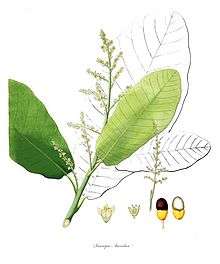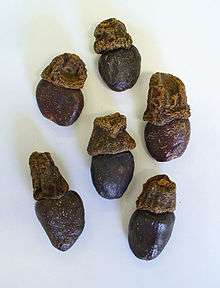Semecarpus anacardium
| Semecarpus anacardium | |
|---|---|
 | |
| Scientific classification | |
| Kingdom: | Plantae |
| Clade: | Angiosperms |
| Clade: | Eudicots |
| Clade: | Rosids |
| Order: | Sapindales |
| Family: | Anacardiaceae |
| Genus: | Semecarpus |
| Species: | S. anacardium |
| Binomial name | |
| Semecarpus anacardium | |
Semecarpus anacardium (Hindi: भिलावा, Marathi: बीबा/बीब्बा, Nepali: भलायो, Assamese: ভলা, Tibetan:གོ་བྱེ། Sanskrit: अग्निमुख) is a native of India, found in the outer Himalayas to Coromandel Coast. It is closely related to the cashew.[1]
Etymology
It is known as Bhallaatak (Hindi: भल्लातक) in India and was called "marking nut" by Europeans, because it was used by washermen to mark cloth and clothing before washing, as it imparted a water insoluble mark to the cloth. It is also known as Gudde Geeru (Kannada: ಗುಡ್ಡೆ ಗೇರು ಬೀಜ) in Kannada and bibba in Marathi and Jeedi Ginja in Telugu.
Plant and fruit features
It is a deciduous tree. Like the closely related cashew, the fruit is composed of two parts, a reddish-orange accessory fruit and a black drupe that grows at the end. The nut is about 25 millimetres (1 in) long, ovoid and smooth lustrous black. The accessory fruit is edible and sweet when ripe, but the black fruit is toxic and produces a severe allergic reaction if it is consumed or its resin comes in contact with the skin. The seed inside the black fruit, known as godambi (गोडम्बी), is edible when properly prepared.
Uses in traditionnal medicine
It is used for improving sexual power and increasing sperm count, curing diseases related to digestive system, balancing Kapha dosha (कफ दोष) in body. It is said that, no Kapha dosha remains after it is treated with this fruit. The red-orange part is collected and dried in sun. It is consumed after it is semi-dried. If consumed in very large quantity, it is said to induce abortion. In moderation, it is however considered good for female reproductive system.[2]
Uses & Side Effects

Various parts of these plants are commonly used in the Ayurvedic system of medicine for the treatment of various ailments, mainly alimentary tract and certain dermatological conditions. Reports have shown noticeable impact on illnesses related to the heart, blood pressure, respiration, cancer and neurological disorders [8-10][3] The seed inside the samecarpus anacardium is known as "Godambi" in Hindi and is widely used in India as dry fruit. Godambi is eaten by Indians in winter and was commonly used as a method of birth control for women.[4]
Apart from its medicinal properties it is also poisonous without any purification. And the oil from its seeds can give blisters and painful wounds.
References
| Wikimedia Commons has media related to Semecarpus anacardium. |
- ↑ Henriette's Herbal Homepage
- ↑ "Bhallatak".
- ↑ Patel, Sanjay R. "In Vitro Cytotoxicity Activity of Semecarpus anacardium Extract Against Hep 2 Cell Line and Vero Cell Line" (PDF). International Journal of PharmTech Research. Spinx. 1 (4): 1429–1433. ISSN 0974-4304.
- ↑ Sold by Patricia McCormick page 11
Further reading
- Puri, H. S. (2003) RASAYAN: Ayurvedic Herbs for Longevity and Rejuvenation. Taylor & Francis, London. pages 74–79.
- Wealth of India, Raw Materials. Vol IX, Council of Scientific and Industrial Research, New Delhi, 1972
- Kleinsasser O., Tumors of the Larynx and Hypopharynx, Georg Thieme Verlag, Stuttgart, 1988.
- Robin P.E., Reid A., Powell D.J. and McCnkey C.C., The Incidence of Cancer of the Larynx, Clinotolarygol, 1991, 16, 198-201.
- Marck P.A. and Lupin A.J., Cancer of the Northern Alberta Experience, J otolaryngol, 1989, 18, 344-349.
- Stephenson W.T., Barnes D.E., Holmes F.F. and Norris C.W, Gender Influences Subsite of Origin of Laryngeal Carcinoma, Arch otolaryngol head neck syrg., 1991, 117, 774-778.
- Tuyns A.J., Laryngeal cancer, Cancer surv.,1994, 19-20, 159-173.
- Martensson B., Epidermiological Aspects on Laryngeal Carcinoma in Scandina Via, Laryngoscope, 1975, 85, 1185-1189.
- Yang P.C., Thomas D.B., Darling J.R. and Davis S., Differences in the Sex Ratio Of Laryngeal Cancer Incidence Rates By Anatomic Subsite, J clin epidemiol, 1989, 42, 755-758.
- Kurup P.N., Ramdas V.N., Joshi P., In Handbook of Medicinal Plants, New Delhi, Oxford & IBH Publishing Co. Pvt. Ltd, 1979, 32.
- Raghunath S., Mitra R., In: Pharmacognosy of Indigenous Drugs, New Delhi, Oxford & IBH Publishing Co. Pvt. Ltd, 1982,185.
- Sharma A., Mathur R., Dixit V.P., Hypocholesterolemic Activity of Nutshell Extract of Semecarpus anacardium (Bhilawa) in Cholesterol Fed Rabbits, Ind J Expt Biol., 1995, 33, 444-8.
- Freshney R.I., Culture of Animal Cells, A Manual of Basic Technique, 5th edition, Wiley-Liss, 200- 201.
- Mohanta T.K., Patra J.K., Rath S.K., Pal D.K. and Thatoi H.N., Evaluation of Antimicrobial Activity and Phytochemical Screening of Oils and Nuts of Semicarpus Anacardium, Scientific Research and Essay, 2007, 11, 486-490.
- Phillips H.J. and Terryberry J.E., Counting Actively Metabolizing Tissue Cultured Cells, Exp. Cell. Res., 1957, 13, 341-347.
- Masters R.W., Animal Cell Culture, Third Edition, Cytotoxicity and Viability Assays.
- Skehan P., Evaluation of Colorimetric Protein and Biomass Stains for Assaying Drug Effects Upon Human Tumor Cell Lines, Proc. Amer. Assoc. Cancer Res., 1989, 30, 2436
- Skehan P., New Colorimetric Cytotoxicity Assay for Anticancer-Drug Screening, Journal National Cancer Institute, 1990, 82, 1107-1112.
- Masters R.W., Animal Cell Culture, Cytotoxicity and Viability Assays, Third Edition, 202-203.